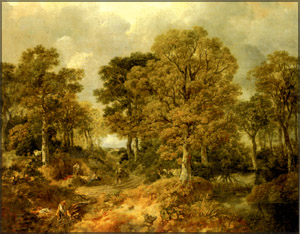Gainsborough: Passion for landscape
Gwen Herat
|

Conrad Wood (1748): Gainsborough’s 48”x 61” painting at the National
Gallery, London.
|
ART: Conrad Wood painted in 1748 (48’x 61’) which hangs in the
National Gallery of London is one of Gainsborough’s specialised idyllic
and contrived paintings.
As landscape paintings were not much appreciated in England of his
time and art lovers preferring picturesque than to direct-nature
painting, Gainsborough had to find away to break this false tradition.
It came in the way of adopting Claude’s (1600-82) idiom of painting
the English countryside, wooded, flowing valleys, rising mountains, etc.
He used typical English scenery in a balanced composition for which he
used nature to best advantage. Suddenly, art critics stood up acclaimed
his supremacy over landscape and he sold his paintings even before they
dried up.
Thomas Gainsborough (1727-1788) is probably the best loved of all
British painters. Specialising in portraits he branched off to
landscaping in later years. Born to a wealthy Suffolk family,
Gainsborough possessed engaging manners with a dignified character that
saw him into any company.
He moved into the fashionable city of Bath, blessed with good and
cheerful manners, became a worthy successor to Van Dycke. All his life,
he preferred landscape and was gaining such spectacular supremacy over
his art that many firmly believed that he was a challenge to the
already-established icon, Reynolds.
Being the youngest in a family of nine children, he came into a lot
of pampering and love. They were a bunch of creativity and talent.
Brother, Humphrey won an award for creating a drill-plough for the
development of steam engine while another brother, Jack tried to fly
with copper wings and invented a cradle which rocked by itself.
Many of them were artistic or musical while little Thomas waited in
the wings to become England’s greatest painter. His mother who was an
amateur painter, encouraged her talented son and sent him to London when
he was barely 13 years old.
He picked up so fast, moved from one great master to another and
Gainsborough mesmerised his tutors who recognised his wizardry even
before he left his teens. Around 1745, he set up his own studio in
Hatton Garden, making a living through paintings.
Gainsborough met the beautiful Margaret, an illegitimate child
fathered by the Duke of Beaufort. It was a stable marriage though she
proved to be a difficult wife to live with.
Gainsborough used to hire a coach and alight from it so that she
would not see him in order to keep it a secret the prices of some of his
paintings. Margaret could not overcome her parsimony and Gainsborough
was helpless about it.
They had two lovely daughters of whom Gainsborough was very fond of
and used them as the models for his paintings. His father died in 1748
which made him return to Sudbury. Once again he moved to Ipswich and
remained there for the next seven years. Gainsborough’s talents
blossomed during the Sulfolk period.
The painter’s convivial personality endeared him to his sitters as
word got around for him to be commissioned by more and more wealthy
patrons and by 1766, he became rich enough to move over to a house in
the fashionable, circus, a stone’s throw away from the Royal Crescent.
He gained many commissions from the wealthy and the influential as
his rapidly growing reputation sky rocketed to bring him more finances.
He also gained access to the private collection and this was valuable
experience as there were no national galleries where the exhibitions
were held.
These originals impressed him. At Wilton he was able to get a closer
look at the Earl of Pembroke’s fine collection of Van Dycke.
Gainsborough was highly influenced by Van Dycke and maintained the
costumes of Van Dycke’s era. Gainsborough’s Blue Boy is a replica of Van
Dycke’s characters.
He was also tremendously influenced by the landscapes of Rubens.
However, Gainsborough remained his own artist with no other Master
gaining control over his art.
As landscape dominated his art, Gainsborough remained true to nature
and drew upon the diverse influences of French Rococo and the 17th
century landscapes to create his personal vision, his adorable English
countryside. Clearly this sort of precision was possible only to someone
of high calibre.
His technique was unique. The remarkable texture, quality of his work
even surprised painters such as Reynolds. In order to achieve
spectacular effect, he used long brushes and diluted paints with
turpentine.
He prepared his own light varnishes but used them sparingly. As a
result of this method, Gainsborough’s canvasses were better preserved.
Gainsborough was blessed with the style that was distinctive in the way
he painted with feathery brush strokes, especially on foliage, trees,
hedges and plants.
The strokes were very short and crisp and rough towards one
direction. By this method, he focused a distance between trees and
foliage without overlapping into one mass of foliage. Each plant, tree
and leaves separated themselves in a manner but in a glorious unity of
nature’s beauty to form his masterpieces. |

